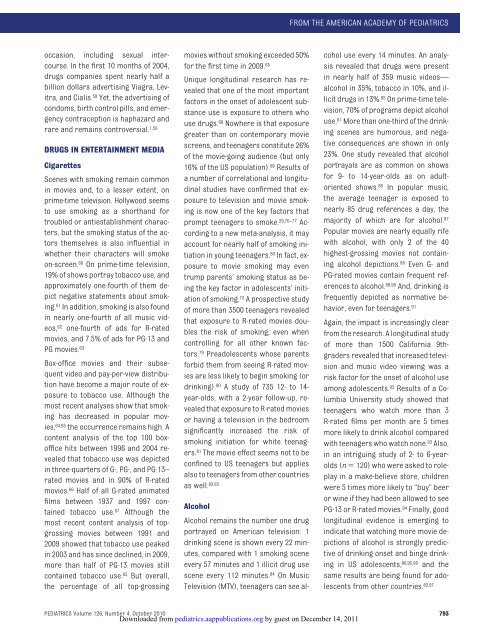Children, Adolescents, Substance Abuse, and the Media
Children, Adolescents, Substance Abuse, and the Media
Children, Adolescents, Substance Abuse, and the Media
Create successful ePaper yourself
Turn your PDF publications into a flip-book with our unique Google optimized e-Paper software.
FROM THE AMERICAN ACADEMY OF PEDIATRICSoccasion, including sexual intercourse.In <strong>the</strong> first 10 months of 2004,drugs companies spent nearly half abillion dollars advertising Viagra, Levitra,<strong>and</strong> Cialis. 58 Yet, <strong>the</strong> advertising ofcondoms, birth control pills, <strong>and</strong> emergencycontraception is haphazard <strong>and</strong>rare <strong>and</strong> remains controversial. 1,59DRUGS IN ENTERTAINMENT MEDIACigarettesScenes with smoking remain commonin movies <strong>and</strong>, to a lesser extent, onprime-time television. Hollywood seemsto use smoking as a shorth<strong>and</strong> fortroubled or antiestablishment characters,but <strong>the</strong> smoking status of <strong>the</strong> actors<strong>the</strong>mselves is also influential inwhe<strong>the</strong>r <strong>the</strong>ir characters will smokeon-screen. 60 On prime-time television,19% of shows portray tobacco use, <strong>and</strong>approximately one-fourth of <strong>the</strong>m depictnegative statements about smoking.61 In addition, smoking is also foundin nearly one-fourth of all music videos,62 one-fourth of ads for R-ratedmovies, <strong>and</strong> 7.5% of ads for PG-13 <strong>and</strong>PG movies. 63Box-office movies <strong>and</strong> <strong>the</strong>ir subsequentvideo <strong>and</strong> pay-per-view distributionhave become a major route of exposureto tobacco use. Although <strong>the</strong>most recent analyses show that smokinghas decreased in popular movies,64,65 <strong>the</strong> occurrence remains high. Acontent analysis of <strong>the</strong> top 100 boxofficehits between 1996 <strong>and</strong> 2004 revealedthat tobacco use was depictedin three-quarters of G-, PG-, <strong>and</strong> PG-13–rated movies <strong>and</strong> in 90% of R-ratedmovies. 66 Half of all G-rated animatedfilms between 1937 <strong>and</strong> 1997 containedtobacco use. 67 Although <strong>the</strong>most recent content analysis of topgrossingmovies between 1991 <strong>and</strong>2009 showed that tobacco use peakedin 2003 <strong>and</strong> has since declined, in 2009,more than half of PG-13 movies stillcontained tobacco use. 65 But overall,<strong>the</strong> percentage of all top-grossingmovies without smoking exceeded 50%for <strong>the</strong> first time in 2009. 65Unique longitudinal research has revealedthat one of <strong>the</strong> most importantfactors in <strong>the</strong> onset of adolescent substanceuse is exposure to o<strong>the</strong>rs whouse drugs. 68 Nowhere is that exposuregreater than on contemporary moviescreens, <strong>and</strong> teenagers constitute 26%of <strong>the</strong> movie-going audience (but only16% of <strong>the</strong> US population). 69 Results ofa number of correlational <strong>and</strong> longitudinalstudies have confirmed that exposureto television <strong>and</strong> movie smokingis now one of <strong>the</strong> key factors thatprompt teenagers to smoke. 29,70–77 Accordingto a new meta-analysis, it mayaccount for nearly half of smoking initiationin young teenagers. 80 In fact, exposureto movie smoking may eventrump parents’ smoking status as being<strong>the</strong> key factor in adolescents’ initiationof smoking. 73 A prospective studyof more than 3500 teenagers revealedthat exposure to R-rated movies doubles<strong>the</strong> risk of smoking, even whencontrolling for all o<strong>the</strong>r known factors.79 Preadolescents whose parentsforbid <strong>the</strong>m from seeing R-rated moviesare less likely to begin smoking (ordrinking). 80 A study of 735 12- to 14-year-olds, with a 2-year follow-up, revealedthat exposure to R-rated moviesor having a television in <strong>the</strong> bedroomsignificantly increased <strong>the</strong> risk ofsmoking initiation for white teenagers.81 The movie effect seems not to beconfined to US teenagers but appliesalso to teenagers from o<strong>the</strong>r countriesas well. 82,83AlcoholAlcohol remains <strong>the</strong> number one drugportrayed on American television: 1drinking scene is shown every 22 minutes,compared with 1 smoking sceneevery 57 minutes <strong>and</strong> 1 illicit drug usescene every 112 minutes. 84 On MusicTelevision (MTV), teenagers can see alcoholuse every 14 minutes. An analysisrevealed that drugs were presentin nearly half of 359 music videos—alcohol in 35%, tobacco in 10%, <strong>and</strong> illicitdrugs in 13%. 85 On prime-time television,70% of programs depict alcoholuse. 61 More than one-third of <strong>the</strong> drinkingscenes are humorous, <strong>and</strong> negativeconsequences are shown in only23%. One study revealed that alcoholportrayals are as common on showsfor 9- to 14-year-olds as on adultorientedshows. 86 In popular music,<strong>the</strong> average teenager is exposed tonearly 85 drug references a day, <strong>the</strong>majority of which are for alcohol. 87Popular movies are nearly equally rifewith alcohol, with only 2 of <strong>the</strong> 40highest-grossing movies not containingalcohol depictions. 88 Even G- <strong>and</strong>PG-rated movies contain frequent referencesto alcohol. 89,90 And, drinking isfrequently depicted as normative behavior,even for teenagers. 91Again, <strong>the</strong> impact is increasingly clearfrom <strong>the</strong> research. A longitudinal studyof more than 1500 California 9thgradersrevealed that increased television<strong>and</strong> music video viewing was arisk factor for <strong>the</strong> onset of alcohol useamong adolescents. 92 Results of a ColumbiaUniversity study showed thatteenagers who watch more than 3R-rated films per month are 5 timesmore likely to drink alcohol comparedwith teenagers who watch none. 93 Also,in an intriguing study of 2- to 6-yearolds(n 120) who were asked to roleplayin a make-believe store, childrenwere 5 times more likely to “buy” beeror wine if <strong>the</strong>y had been allowed to seePG-13 or R-rated movies. 94 Finally, goodlongitudinal evidence is emerging toindicate that watching more movie depictionsof alcohol is strongly predictiveof drinking onset <strong>and</strong> binge drinkingin US adolescents, 86,95,96 <strong>and</strong> <strong>the</strong>same results are being found for adolescentsfrom o<strong>the</strong>r countries. 82,97PEDIATRICS Volume 126, Number 4, October 2010 793Downloaded from pediatrics.aappublications.org by guest on December 14, 2011
















